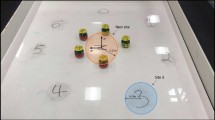Abstract
The best-of-n problem (Valentini et al. in Front Robot AI 4(9):1–18, 2017) is one of the decision-making problems in which many robots (agents) select the best option among a set of n alternatives and are focused on the field of Swarm Robotics. Almost all of the previous studies focused on binary decision-making scenarios (\(n = 2\)) and could not be applied without any change in the case of \(n> 2\). It is necessary to satisfy constraints on the number of robots N, or the time required for reaching the best option is abruptly increased. Therefore, it is required to construct a method that can deal with \(n> 2\). In this paper, we propose an algorithm (BRT model, bias and rising threshold model) in which the time and the possibility of reaching agreement are not dependent on the number of robots N even when \(n> 2\). By computer experiments, our claims are verified within the tested parameter ranges.











Similar content being viewed by others
References
Valentini G, Ferrante E, Dorigo M (2017) The best-of-n problem in robot swarms: formalization, state of the art, and novel perspectives. Front Robot AI 4(9):1–18
Reynolds CW (1987) Flocks, herds and schools: a distributed behavioral model. ACM SIGGRAPH Comput Graph 21(4):25–34
Olfati-Saber R, Murray RM (2004) Consensus problems in networks of agents with switching topology and time-delays. IEEE Trans Autom Control 49(9):1520–1533
Iwanaga S, Namatame A (2002) The complexity of collective decision. Nonlinear Dyn Psychol Life Sci 6(2):137–158
Wessnitzer J, Melhuish C (2003) Collective decision-making and behaviour transitions in distributed ad hoc wireless networks of mobile robots: target-hunting. In: Banzhaf W, Ziegler J, Christaller T, Dittrich P, Kim JT (eds) Advances in artificial life, ECAL 2003, lecture notes in computer science, vol 2801. Springer, Berlin
Parker CAC, Zhang H (2009) Cooperative decision-making in decentralized multiple-robot systems: the best-of-n problem. IEEE/ASME Trans Mechatron 14:240–251. https://doi.org/10.1109/TMECH.2009.2014370
Todd Peter M (1997) Searching for the next best mate, simulating social phenomena. Springer, Berlin, pp 419–436
Phung NH, Kubo M, Sato H, Iwanaga S, Namatame A (2017) Agreement algorithm using the trial and error method at the macro level. In: Proceedings of SWARM 2017: the second international symposium on swarm behavior and bio-inspired robotics. pp 82–85
Namatame A (2001) Strategic decision making (In Japanese). Asakura Publisher, Tokyo, pp 119–149
Kubo M, Phung NH, Sato H, Namatame A (2015) Direction switch behavior to enclose a pack of targets based on phase transition. In: Proceedings of SWARM 2015: the first international symposium on swarm behavior and bio-inspired robotics. pp 295–298
Phung NH, Kubo M, Sato H, Iwanaga S, Namatame A (2015) Enclosing of target zone. In: Proceedings of SWARM 2015: the first international symposium on swarm behavior and bio-inspired robotics
Author information
Authors and Affiliations
Corresponding author
About this article
Cite this article
Phung, N., Kubo, M., Sato, H. et al. Agreement algorithm using the trial and error method at the macrolevel. Artif Life Robotics 23, 564–570 (2018). https://doi.org/10.1007/s10015-018-0489-z
Received:
Accepted:
Published:
Issue Date:
DOI: https://doi.org/10.1007/s10015-018-0489-z




